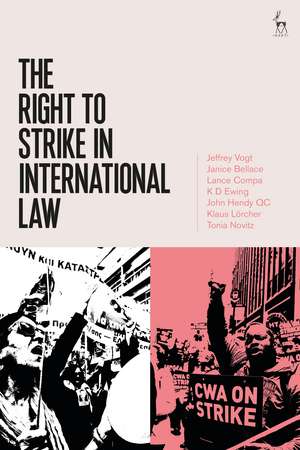The Right to Strike in International Law
Autor Jeffrey Vogt, Janice Bellace, Lance Compa, K D Ewing, John Hendy QC, Klaus Lörcher, Tonia Novitzen Limba Engleză Paperback – 22 sep 2021
| Toate formatele și edițiile | Preț | Express |
|---|---|---|
| Paperback (1) | 231.51 lei 6-8 săpt. | |
| Bloomsbury Publishing – 22 sep 2021 | 231.51 lei 6-8 săpt. | |
| Hardback (1) | 512.37 lei 6-8 săpt. | |
| Bloomsbury Publishing – 18 mar 2020 | 512.37 lei 6-8 săpt. |
Preț: 231.51 lei
Preț vechi: 297.45 lei
-22% Nou
Puncte Express: 347
Preț estimativ în valută:
44.30€ • 46.35$ • 36.80£
44.30€ • 46.35$ • 36.80£
Carte tipărită la comandă
Livrare economică 02-16 aprilie
Preluare comenzi: 021 569.72.76
Specificații
ISBN-13: 9781509955923
ISBN-10: 1509955925
Pagini: 272
Dimensiuni: 156 x 234 mm
Greutate: 0.38 kg
Editura: Bloomsbury Publishing
Colecția Hart Publishing
Locul publicării:London, United Kingdom
ISBN-10: 1509955925
Pagini: 272
Dimensiuni: 156 x 234 mm
Greutate: 0.38 kg
Editura: Bloomsbury Publishing
Colecția Hart Publishing
Locul publicării:London, United Kingdom
Caracteristici
Author team is of the highest calibre, combining leading European and US labour law academics and practitioners
Notă biografică
Jeffrey Vogt is Rule of Law Director, Solidarity Center.Janice Bellace is Samuel A Blank Professor Emeritus of Legal Studies and Business Ethics, University of Pennsylvania, Wharton.Lance Compa is Senior Lecturer at the School of Industrial and Labor Relations, Cornell University.K D Ewing is Professor of Public Law at King's College London.Lord Hendy QC is a barrister at Old Square Chambers, London and Honorary Professor in the Faculty of Law, University College, London.Klaus Lörcher is former Legal Adviser to the European Trade Union Confederation and former Legal Secretary of the Civil Service Tribunal of the European Union.Tonia Novitz is Professor of Labour Law at the University of Bristol.
Cuprins
PART IAN INTRODUCTION1. Understanding the International Labour Organization (ILO) I. An ILO Primer 2. The Ill-Founded Challenge to the Right to Strike in 2012 I. The Showdown at the 2012 International Labour Conference II. Why Then? III. And Now? PART IIA REBUTTAL: ON THE QUESTION OF MANDATES3. The ILO Committee of Experts has a Mandate to 'Interpret' ILO Conventions, not the Constituents I. A Brief History II. The Mandates of ILO Supervisory Bodies Establish No Hierarchy Among Them III. The Committee of Experts and the Interpretation of Conventions IV. Conclusion PART IIIA REBUTTAL: THE INDISPUTABLE CASE FOR THE RIGHT TO STRIKE4. The Rules of Interpretation: The Vienna Convention on the Law of Treaties (VCLT) I. Applicability of the VCLT II. VCLT Rules of Interpretation as Customary International LawIII. ILO Practice 5. The Ordinary Meaning of Convention 87 Supports the Existence of a Right to Strike 6. The Object and Purpose of Convention 87 Supports the Existence of a Right to Strike 7. The Subsequent Agreement and Practice between the Parties Concerning Convention 87 Supports the Existence of a Right to Strike: ILO JurisprudenceI. Some History II. The Right to Strike is Enshrined in Convention 87 III. The ILO Constitution IV. The Right to Strike in Subsequent ILO Instruments V. 2015 Tripartite Meeting on the Right to Strike 8. The Subsequent Agreement and Practice between the Parties Concerning Convention 87 Supports the Existence of a Right to Strike: Beyond the ILO I. United Nations II. Council of Europe Instruments III. The Right to Strike and the European Union IV. The Inter-American System V. African Charter on Human and Peoples' Rights VI. The Right to Strike and Trade Arrangements VII. High Court Cases Since 2012 Affirm the Right to Strike 9. Other Methods under Article 31 of the Vienna Convention on the Law of Treaties (VCLT) Support the Existence of the Right to Strike I. 'Any Relevant Rules of International Law Applicable in the Relations between the Parties' (Article 31(3)(c) VCLT) II. 'A Special Meaning Shall be Given to a Term if it is Established that the Parties So Intended' (Article 31(4) VCLT) III. Further Interpretation PrinciplesIV. Inadmissible 'Creative Interpretation'? 10. Though Unwarranted, Article 32 of the Vienna Convention on the Law of Treaties (VCLT) also Supports the Existence of the Right to Strike I. Resort to the Preparatory Work of Convention 87 is Unwarranted II. Application of Article 32 VCLT would Not Affect the Outcome were it Applied 11. The Right to Strike is Recognised as Customary International Law I. The United Nations II. The ILO III. National Constitutions IV. Legislation V. Judicial Opinion VI. Conclusion PART IVWHERE TO FROM HERE?12. Settling the Dispute: The International Court of Justice? 13. The Aftermath I. Impact on ILO Supervisory SystemII. The Impact Outside the ILO 14. Conclusion I. The Return of the Strike
Recenzii
There is no doubt that the book under review makes an important contribution to the discussion of whether Article 3 Convention No 87 enshrines a right to strike as such, and will therefore serve in every further discussion on this subject as an important reference.
A scholarly legal document which will be of interest to students and practitioners of collective labour law and scholars of decision making in international organizations. At the same time, however, it is written and presented in an accessible way, with the minimum of legalese, making it a useful handbook for trade unionists, industrial relations academics and students and anybody with a wider concern for fairness and equity at work.
A scholarly legal document which will be of interest to students and practitioners of collective labour law and scholars of decision making in international organizations. At the same time, however, it is written and presented in an accessible way, with the minimum of legalese, making it a useful handbook for trade unionists, industrial relations academics and students and anybody with a wider concern for fairness and equity at work.
